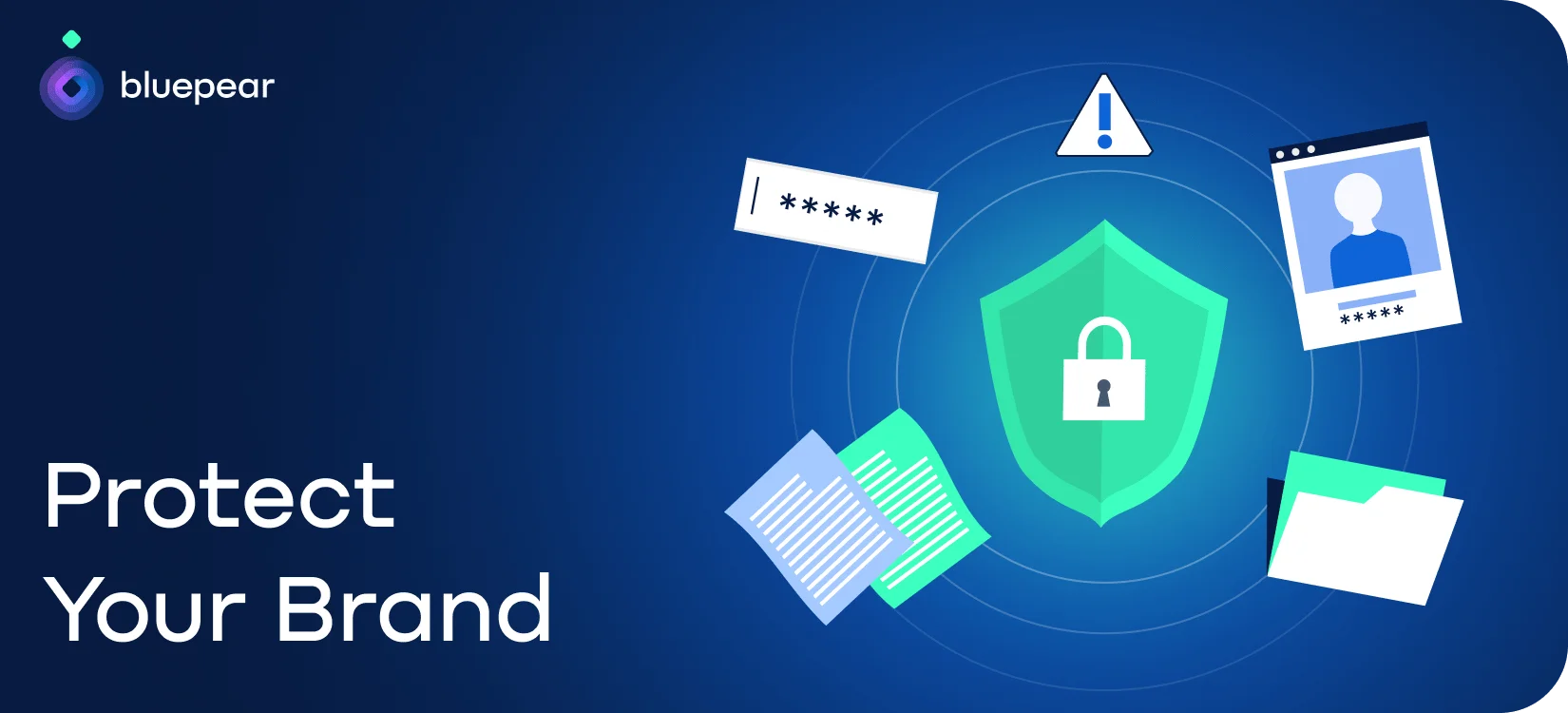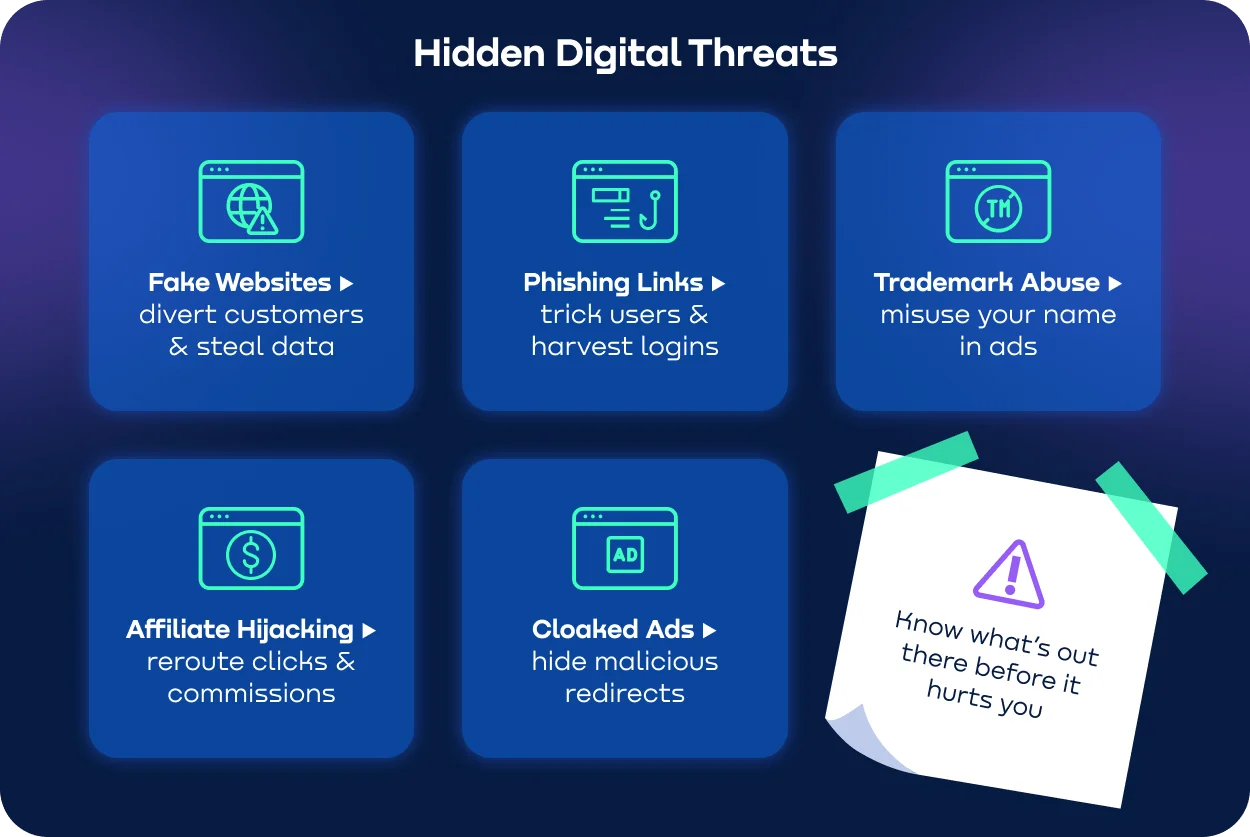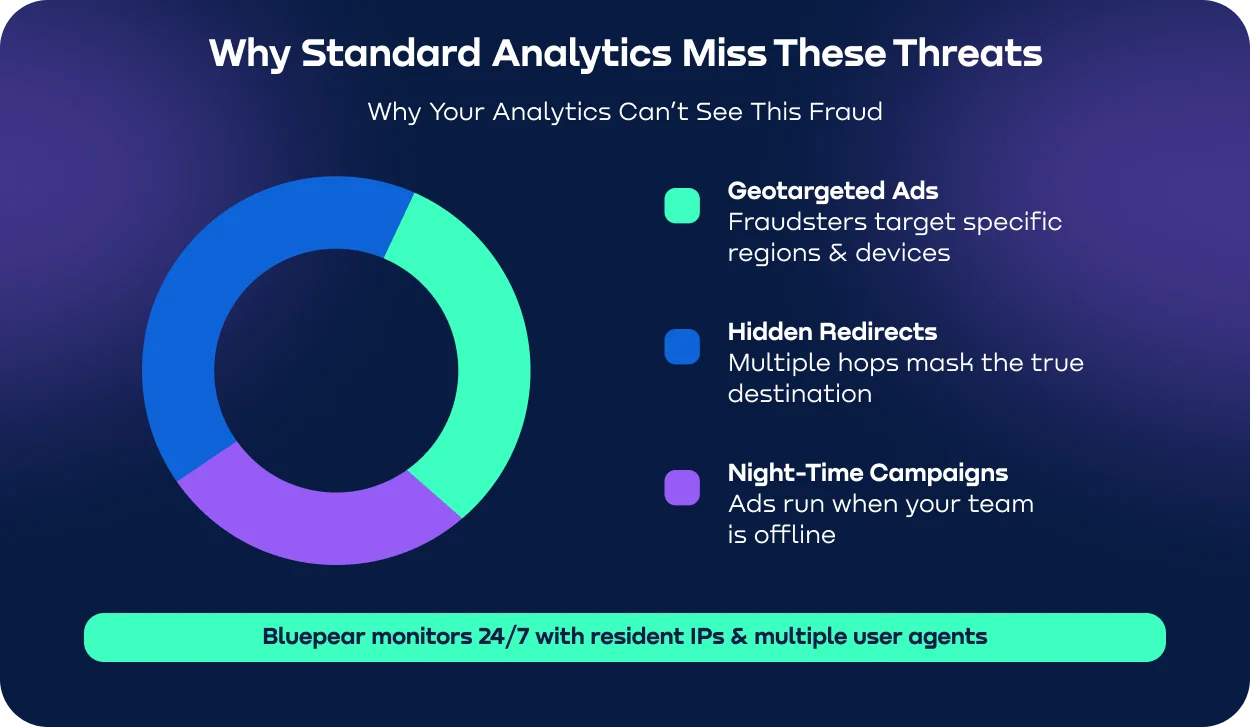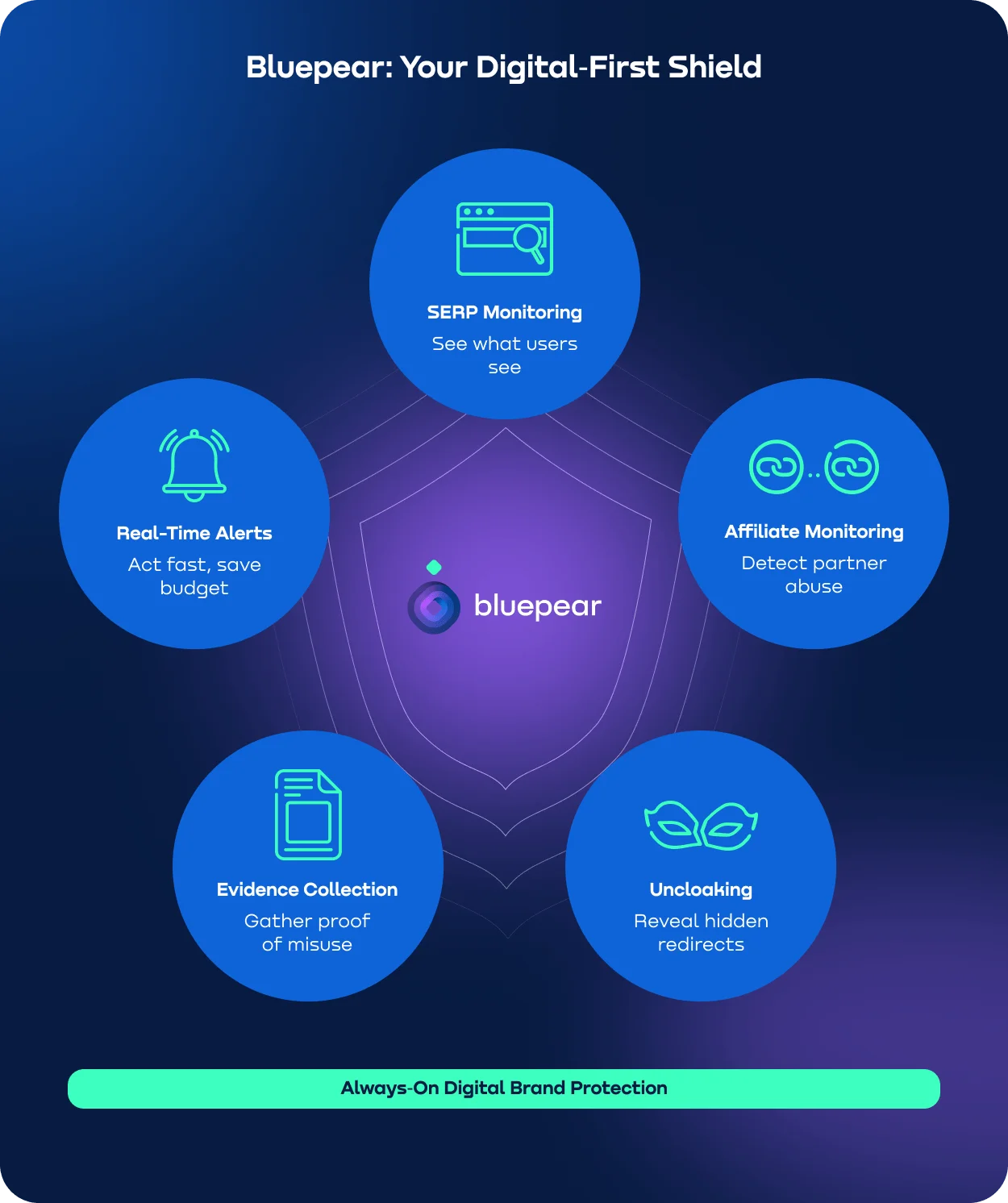
Contents
E-commerce and digital marketing bring enormous growth opportunities, but they also expose brands to risks most teams underestimate. While PR can handle negative reviews and legal teams can protect trademarks, fraudsters today move faster, using automation, fake sites, and hidden redirects to quietly steal traffic and revenue. That’s why digital risk monitoring becomes essential for protecting brand at scale.
The scale is staggering: in 2023, 22% of global digital ad spend, around $84 billion, disappeared due to ad fraud (Juniper Research). Add to this payment fraud, fake affiliates, and social impersonation, and it becomes clear: traditional brand protection solutions can’t keep up with modern threats.
To protect both revenue and reputation, brands need a digital-first approach – one that detects and stops hidden threats before they become visible losses. Protecting your brand online is a core growth strategy.
Brand Protection in the Digital Age
Protecting brand name today goes far beyond registering trademarks or running PR campaigns. It means protecting brand identity, reputation, and digital assets against threats that can show up anywhere. Companies serious about protecting brand should integrate compliance, monitoring, and technology from day one.
Trademarks. Around 85% of brands experience some form of infringement, and nearly three-quarters of them take legal action. Each case can cost between $50,000 and $250,000 (CompuMark). For companies in e-commerce or fintech, where brand equity drives customer trust, even a single infringement can translate into lost sales and costly disputes. Strong brand protection solutions reduce these risks.
Intellectual property. Beyond trademarks, intellectual property includes patents, copyrighted content, and proprietary materials. Counterfeits are on the rise, so digital risk monitoring is critical to prevent copying or misuse.
Reputation. Your brand’s reputation is fragile online. Research shows that 45% of consumers are unsure which sites are legitimate, causing revenue loss for 38% of affected businesses and reputational damage for 37%. In sectors where customer acquisition is expensive, such as digital banking, travel, or insurance, reputational hits quickly translate into measurable financial pain. Here, protecting brand reputation is as important as protecting assets and protecting your brand online must be part of every risk strategy.
Digital risk and paid search. Digital threats today extend deep into marketing channels. Fraudsters can inflate CPC by 34% while reducing CTR by 29%. Between 45% and 68% of paid traffic may be diverted, and about 14% of clicks are fraudulent. Losses that globally exceed $61 billion. For performance-driven sectors like e-commerce or fintech, this doesn’t just erode ROI, it undermines customer experience at the very point of acquisition. Only brand protection solutions with automated digital risk monitoring can close this gap.
Digital Dangers Your Brand Might Not See
Modern brand threats often stay invisible until the damage is done. They quietly drain budgets, steal customers, and erode trust. Companies that invest in protecting brand and brand protection solutions avoid losses that others often discover too late.
Fake websites and phishing. When launching a new product line, customers searching for your store may land on a site that looks identical to yours but is fraudulent. Payments are diverted to criminals, and when orders never arrive, support teams face angry customers and reputational fallout. Even a single fake site can mislead thousands if it spreads through search or social channels.
TA and brand bidding. You notice your CPC is higher than usual. After checking, you see competitors or even some affiliates are bidding on your branded keywords. Your ads are pushed lower in search results, users click elsewhere, and your campaign budget drains faster than expected. Protecting your brand online without constant monitoring, you might not realize this is happening until it significantly affects ROI.
Affiliate hijacking and cloaked ads. Unscrupulous partners may reroute traffic through hidden redirects or cloaked offers. On dashboards, metrics look normal, but real conversions drop because leads are stolen before reaching checkout. Mobile campaigns are especially vulnerable, with click injection draining performance budgets in the background.
Social media and app impersonation. For instance, a fake Instagram account pops up using your logo and branding, offering discounts or promotions you never approved. Customers interact with it, some even make purchases or share personal info. Your real social channels see confusion, your community questions authenticity, and the reputation you’ve built over years suffers.
| Threat | Example |
|---|---|
| Fake website & phishing | Customer click fake sites, payments stolen, trust damaged |
| TA abuse & brand bidding | Higher CPC, ads pushed down, potential customers click everywhere |
| Affiliate hijacking & cloaked ads | Leads rerouted, conversions drop, analytics misleading |
| Social media & app impersonation | Fake accounts/apps mislead customers, reputation suffers |

How Hidden Threats Hurt Your Marketing Results
Even if you check Google Ads or Analytics every day, some issues remain invisible. Standard reports don’t show hidden domains, masked redirects, or altered UTM tags. Because of this, businesses face real financial losses.
Your cost per click can go up without any clear reason. Studies show that when competitors or affiliates bid on branded keywords, CPC can rise by up to 20% and CTR can drop by almost 29% (Dreamdata). This means your ads lose visibility, while your budget drains faster. Digital risk monitoring identifies this early, protecting brand performance.
Some traffic doesn’t reach your site at all. Research shows that about 14-20% of PPC clicks are fraudulent or invalid (ClickPatrol). On a global scale, this adds up to billions lost each year. That’s why brand protection solutions and protecting your brand online are mandatory in PPC heavy industries.
Data from your analytics can also be misleading. Misleading clicks make it hard to know what works. Decisions based on this data can waste budget, cost sales, and hurt trust.
How Fraudsters Hide From Analytics
At first glance, everything might look fine in your dashboard. Clicks are coming in, conversions seem steady. But have you ever wondered why some sales never reach your site? The truth is, some traffic is quietly being diverted before anyone notices.
- • Cloaking. A landing page seems normal when checked internally. But visitors see a different version. Fake offers, phishing forms, customers get confused, and the team never sees it.
- • Targeted geo or device campaigns. Some campaigns appear only for certain countries or devices. The office is in the US, but traffic from Brazil or mobile users in Asia can disappear without warning.
- • Nighttime campaigns. Affiliates or competitors sometimes run ads at night or on weekends. By the time the marketing team checks in, the traffic is gone.
- • Referrer masking. Clicks look legitimate in analytics. But digging deeper shows hidden redirects. Identifying which campaign or partner is responsible becomes difficult.
These tricks explain why standard analytics often miss lost traffic, lower conversions, and wasted budget. Juniper Research estimates that global ad fraud will cost businesses over $100 billion annually by 2024, making it one of the largest hidden drains on digital marketing. Without automated digital risk monitoring, these tricks quietly siphon budgets and revenue long before the team realizes what’s happening.

Bluepear: Protect Your Brand in Search and Affiliate Campaigns
Bluepear is a tool built for brands that need to see everything happening with their paid search and affiliate traffic. It monitors your branded search results, affiliate campaigns, and redirects 24/7, alerting you as soon as something looks off.
How it works in practice:
- • Unauthorized keyword use and promo codes. Affiliates or competitors sometimes bid on your branded terms or share promo codes in ways that hurt your ROI. Bluepear catches this in real time and shows exactly what’s happening, where, and who is behind it.
- • Detecting fake sites and typosquatting. Imagine a customer clicks what they think is your link but ends up on a cloned site. Bluepear identifies these sites, follows every redirect, and collects screenshots so you have proof.
- • Monitoring all unapproved uses of your brand. From misleading ads to mentions on coupon or deal aggregators, Bluepear flags anything outside your approved marketing channels.
- • Tracking organic search results for hijacked domains. If a fake URL outranks your official site, Bluepear finds it, helping you recover lost traffic before it affects sales.
- • Real-time evidence collection. Every violation comes with evidence such as links, screenshots, timestamps, so you can act fast. With fraud costing advertisers over $100 billion annually, traditional monitoring is no longer enough.
Machine learning models continuously scan search and affiliate ecosystems, identify suspicious patterns, and adapt to new fraud tactics that manual checks would miss. The system also helps pick the right keywords and monitoring rules automatically, so brands don’t need to guess where to look.
Bluepear combines AI-driven detection with real-time visibility, giving companies the tools for protecting brand name across paid search, affiliates, and organic channels.

Building a Comprehensive Brand Protection Strategy
A strong strategy for protecting brand requires more than a single tool or department. It combines legal safeguards, continuous digital risk monitoring, partner discipline, and a well-prepared team. Only when these elements work together can companies close the gaps that fraudsters exploit.
Step 1. Registering and maintaining trademarks, logos, and domain names gives brands the ownership they need to take swift action against misuse. Without this brand protection solution, even the best monitoring has limited effect.
Step 2. Use automated tools for protecting brand name and track branded search results, affiliate campaigns, and social accounts. This uncovers fake websites, unauthorized brand bidding, and misleading campaigns before they affect traffic or revenue.
Step 3. Define rules for brand bidding, domain use, and promo codes in affiliate contracts. Enforce penalties for violations to prevent partners from taking shortcuts that cost the brand money.
Step 4. Educate employees on phishing, fake websites, and suspicious campaigns. A vigilant team is catching problems early and protecting brand name, revenue and reputation.
Step 5. Finally, evidence and action complete the strategy of protecting brand. Documenting every violation with screenshots, links, and timestamps ensures fast responses from filing takedown requests to alerting partners or pursuing legal action.
Case Study
GourmetDelight
The threats we’ve discussed show that standard analytics often miss critical issues of protecting brand name. In real life, this can cost brands both money and trust.
In 2023, GourmetDelight, an online retailer of premium products with annual revenue of about $150 million, faced a large-scale attack on customer accounts. Hackers used the credential stuffing method, gaining access to ten thousand accounts. Through them, they made unauthorized purchases and stole personal data of customers.
Despite the fact that the company quickly blocked the compromised accounts and notified customers, the direct losses amounted to about $500,000. The reputational effect turned out to be even more painful: many customers lost confidence in the brand and stopped making orders.
This case has shown that even major players in e-commerce are losing money and loyalty without protecting your brand online with constant monitoring and protection systems.
LuxeCart
LuxeCart, an international online luxury goods retailer with revenue of $200 million and more than a million active customers, has also experienced the consequences of the lack of comprehensive brand protection. Clones of the company's website began to appear in search results, intercepting customer traffic and payments.
At the same time, attacks on accounts used for fake orders were recorded, and hidden redirects and unauthorized promo codes surfaced in partner programs. All this led to multimillion-dollar losses and a noticeable drop in customer confidence.
In response, LuxeCart implemented automatic monitoring of brand requests, strengthened control over partner campaigns, and introduced anti-fraud terms into contracts. Six months later, the number of attacks on brand campaigns decreased by more than 40%, and financial losses from affiliate fraud were significantly reduced thanks to these brand protection solutions.
Conclusion
Traditional analytics, legal teams, and PR cannot fight cloaked redirects, hijacked affiliate traffic, or fake websites on their own. Fraudsters adapt too quickly, exploiting every blind spot to drain budgets and steal customers. That’s why protecting brand in the digital age must be proactive, automated, and relentless. Real-time digital risk monitoring, airtight contracts, and AI-driven brand protection solutions are must. They’re the foundation of sustainable growth and the only way to ensure that every dollar you invest in marketing translates into real results.
If your brand is not watching, someone else already is. Protecting your brand online means using technology like Bluepear to stay ahead.
FAQ
What is digital brand protection?
Protecting a brand means monitoring and defending your brand across all online channels, from search and social media to paid campaigns, affiliates, and beyond.
How do fake websites and cloaked ads harm my brand?
They divert your customers, steal information, and can create confusion, leading to lost sales and damaged trust.
Why doesn’t standard analytics show these threats?
Cloaked pages, geo-targeting, and hidden referral links can bypass traditional reports, hiding lost traffic and inflated costs.
How quickly can I react with Bluepear?
With real-time monitoring and alerts, issues are flagged immediately, enabling fast responses before damage escalates.
What legal measures should accompany brand protection?
Trademarks, IP rights, and clear anti-fraud clauses in partner agreements complement monitoring, giving you the tools to act efficiently against violators.

